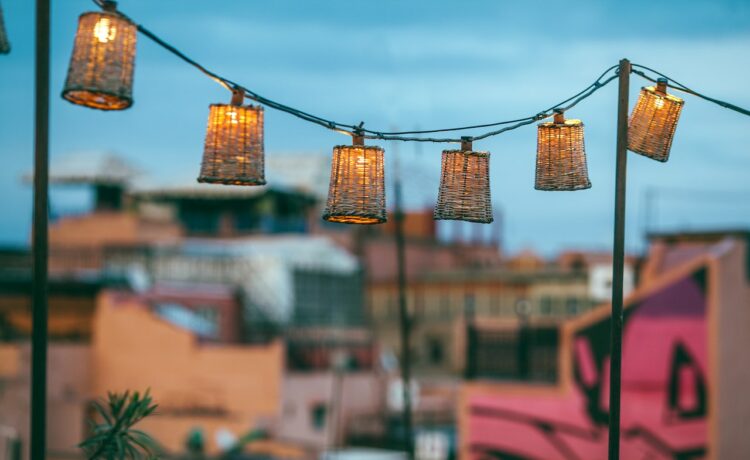String light poles are a great option when you want to avoid the drilling of walls. But are they safer and long-lasting?
If you are thinking of fixing the pole in the sand without considering the pros and cons, the last thing you want is to ruin the street light pole quickly because of the weather, moisture, and conditions and the damage to string light bulbs if it falls out.
String light poles are a great way to hang the string lights to avoid the unnecessary professional labor cost or drilling the walls. You can easily adjust the pole length distance and customize their height according to the string light hanging requirements and the brightness you are looking for near your home surroundings.
In this post, we have covered the easy DIY string light tutorial that will help you to install the string light pole in your home outdoors easily.
Materials for DIY String Light Poles

Gather the material that you will need while DIY the string light poles. Start by preparing the rough sketch on paper so that it’ll save you from confusion and hassle.
Pick up cardboard or old paper sheets to support your workplace. Buy the galvanized electrical Conduit pipes or wooden pole pieces that last long in the weather changes, PVC pipe, Squeeze Connector, hooks or bolts, concrete and cement, Outdoor extension cord, and string lights if you don’t have any of these in reach of your hand. Other tools include-
- Tape Measure
- Level
- Sand Paper
- Philips Screwdriver
- Post Hole digger
- PVC Cutters
- Saw Miters
- Shovel
- No-Dig Ground Anchor Hooks (Optional)
Step-By-Step DIY Ground String Light Poles with Digging
1. Decide the Location and String Light Poles Height

The very first thing you have to do is decide on a particular location where you want to fix the DIY string light poles. And the height of the string light poles you will keep so that it doesn’t lean with the string tension.
Take the conduit pipe or wooden piece to use as the desired post-pole. You can trim it and cut the unwanted length piece of pipe or wooden piece with the help of a cutter to keep the height shorter or of the desired length.
2. Prepare the String Light Poles

Paint the poles if you don’t want them to look shabby. If the metal poles are already galvanized, you can use metallic paint to make them beautiful. Use sandpaper for the wooden piece to give the finishing surface look, and paint them to create a protective layer.
Keep the poles in a non-disturbing place where they can dry so you can use them.
3. Prepare the Forming Tubes

To support the string pole pipes, you will need tubes. You can use PVC pipes or cardboard rolls. Measure the length of the tube piece according to how much you will keep the pole inside the ground base. Keep the tube height a little longer than the depth of the pole ground. Cut the PVC pipe with the PVC cutter.
In the case of a cardboard roll, you can use the hand saw carefully. Close the one end that will go into the ground with the cardboard and strong wider tape. You can pick a longer cardboard piece, keep it flat on the tube surface, cut it according to the tube size, and finally secure it with tape.
4. Dig the Hole

Pick up the post-hole digger and dig the hole in the desired location to install the string light pole. If you want to keep the pole height longer, dig deeper so that it will become sturdy and doesn’t fall off easily if something hits the pole. For example, if you have kept the pole height 10 feet, keep the 8 feet above the ground and the 2 feet at least in the sand for strength.
5. Insert the PVC Pipe

Put the PVC pipe in the hole you have dug for the post. PVC pipe offers support to the pole and will save it from the direct moisture of sand around the area. Fix the sand around the pipe properly so the PVC pipe doesn’t come from the post hole. If you want to fix it for a long time, you can seal the outer layer with cement. If you don’t want to use the PVC pipe, use the old cardboard roll to support the string post-pole.
6. Set the Pole Piece in Place

Pick the pole pieces you have chosen from the metal conduit pipe or wooden, and keep them in the place of support in the hole. Fix it inside the PVC pipe buried in the sand or the cardboard roll tube you have used for the support.
To make it stronger, you can fill the leftover space of the tube with concrete or cement mold. In this case, you must prepare the cement mold just after digging the hole. Pour it when it is wet for the proper setting. If you will use the cement mold, let it free to dry and strengthen itself for the next one or two days. So do the remaining DIY steps after the cement mold dries.
7. Pole Capping

After the pole installation, the very next thing you have to do is cap the poles with the connectors. Pick up the level and mark the place on the pole where you want to hang the lights so you can connect the connectors around the pole. In the case of metal conduit poles, you can use squeeze connectors as they will fix the metal.
You can use connector supports for wooden pieces and screw them with the bolts to hang the string lights. You can also use the hooks and fix them in the wooden pole by drilling a fine small hole. These hooks should fit well in the wooden poles and become sturdy.
Install the hooks on the other side of the wall or terrace deck where you would like to connect the other end of the string lights. You can install one more pole by following the above instructions to hang the string lights on the poles.
8. Hang the String Lights

Once the connects and hooks are installed, fixed, and sturdy, they are ready to use. You can hang the string light over the poles, connectors, and hooks. For security and safety, use the string lights with separate bulb boxes to avoid damage. In this case, you can fix the string bulbs in the string light holders after installation and fit the complete string over the poles and hooks. Ensure that you screw them properly to make them sturdy.
If bulbs are attached to the string light, take the help of another person so that the string lights don’t get damaged while fixing. And your DIY string light poles are ready to glow and brighten up the surrounding.
Step-By-Step DIY Ground String Light Poles Without Digging
1. Decide the Location

Find a suitable location that is flat and sturdy enough to start the DIY project for string light poles. An area near the pebbles and gravels is recommended for more strength. You can also place them around the string light poles after installing them.
2. Prepare the DIY String Light Poles

Decide what height you will need. The pole will be above the ground, and you don’t have to take extra pole length that will go deeper into the ground area. Once you are sure, cut the unwanted ends to get the desired height of metal conduit poles or wooden poles.
Paint the poles from the finishing surface to save them from the changing weather conditions and moisture from the ground and air.
3. Forming Tubes

Prepare the forming tube as described above. Keep both ends open and the forming tubes much wider to construct a thicker base. Ensure that the forming tube height is at least twenty percent of the total height of the pole.
4. Prepare the Cement Mold

Take the cement in a container, add some water, and mix it with the help of a shovel to prepare a liquid cement mold. Ensure that it prepare well so that the mold can spread evenly and provide consistency to the base of the string light pole on the ground.
5. Adjust the Forming Tubes and String Light Poles

Put the forming tubes on the ground where you want to DIY the string light pole. Place the string light pole in the middle of forming tube. Fill the space with concrete. Examine the alignment of the String light pole and keep it straight vertically. Fill the leftovers with the cement molds to hold them tight and fix the pole on the ground.
6. Let the Cement Mold Dry

Postpone the remaining DIY process for two days. Let the concrete and cement mold dry for at least 24 to 48 hours so it becomes strong enough to provide the base for the string light pole. After two days, remove the PVC pile or cardboard roll you had placed around the pipe to support the string pole. The pole base is ready.
7. Cap the String Light Poles and Hang the Lights

Now follow steps seventh and eighth as described above in the “Dig Ground String Light Poles Directions” part. Hang the string lights on your DIY string light pole. And you are ready to use the string lights to brighten up the surrounding.
Tips for DIY String Light Poles and Hanging String Lights
- Keep the string light pole height a little more than the desired length so that while installing it in the ground, if you end up messing with the pole measurements, it doesn’t affect you.
- To avoid damage, use the string lights with separate light bulb boxes you can fix and screw them later.
- If you want to light up the place with more brightness, install the poles closer so that the number of string light bulbs will become closer and denser.
- If you want to attach the other end of the string light to the wall of your home or terrace, use suitable hooks or umbrella bases that will provide enough strength to hold the string light securely.
- To avoid the cement process in the No-dig DIY string light poles process, you can use the No-Dig Ground Anchors. You can easily install it if you have a patio in the outdoors. You can use them if you live in a rented home or need a solution you can easily alter when no longer needed. Take the anchors for flag posts, and install them in the ground by twisting and rotating them in the gravel or pebbles ground. You will need extra force and strength to do so. Pick up the string light pole and fix the anchor flag post properly. Once done, test the sturdy nature and strength of the pole and proceed with the capping and installing string lights on poles as described above in the “DIY Ground String Light Poles Directions.”
Final Thoughts
Everybody wants sturdy and long-lasting string lights outside their home that brighten up the evening and nighttime, and fixing the DIY string light pole in the right way is the way to keep your string lights safer and long-lasting by avoiding unnecessary damage that often happens when string light poles are not sturdy or get damaged because of the weather conditions.
This post showed the easy DIY string light poles tutorials that don’t require much effort or professional skills. We have also covered the materials and tools you will end during the DIY string light pole process. Along with it, it also covered no dig-ground DIY string light poles tutorial.
If you are looking for more ways to make your home or surrounding creative and stunning, sign up and get our best strategies sent to your inbox.









